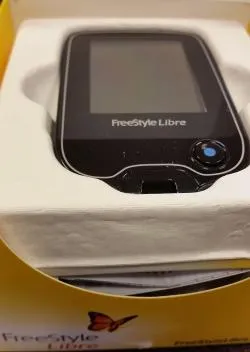Graphene patches to treat diabetes

06/12/2016 10:25 p.m.
I do not know what to comment on this, the graphene apart from the very expensive, is used as a driver in the chips, then there is the reliability of the measurement in sweat, which is not very good, I do not know, as soon as they announce some of Matrix, asSome prehistory as if it were novelty.I do not know if what I comment is nonsense or not, but there would be no way to implement something micro that was flexible and soft material, that I was in contact with the blood and that through a smartwatch receiver that today everyone carries, there would bea connection and the data were collected?But we do not go from something from the future to something Neanderthal.

06/12/2016 10:53 p.m.
DMT1 desde los 12 años (1991)
hbA1c= 5,4
Humalog y Toujeo (mayo 2017)
Humalog y Tresiba (mayo 2016 hasta mayo 2017)
humalog y NPH (desde inicio hasta mayo de 2016)
Men, women and bionic children ... In that they will transform us with so much APPARATE.

06/13/2016 10:54 a.m.
Lada enero 2015.
Uso Toujeo y Novorapid.
I reproduce here the news of El Mundo to facilitate reading:
Control glucose levels in diabetic patients without annoying punctures.That is a dream long persecuted by medicine that, however, has not achieved no non -invasive method as effective as needles.Now, a material like the newcomer of the future, graphene, jumps the limits of electronics to get at the service of science and measure blood sugar levels.
It is almost enough to see the photograph that has disseminated the journal Nature Nanotechnology to summarize the importance and (apparent) simplicity of the device that scientists have developed from the National University of Seoul and and Institute of Technology Gyeonggi -do (both in South Korea),and the American universities of Massachusetts and Austin (in Texas).
Thanks to the flexibility and lightness of graphene, researchers led by DAE-Hyeong have managed to design a transparent bracelet-looking device in which several integrated chips are able to measure glucose levels directly in sweat.In addition, specialists have taken another step - this time only in mice - by adding microagujas capable of administering through the skin the necessary dose of an antidiabetic (metformin) when glucose levels rose.
This is how the device works.Grace Pablos
As one of the co -managers of work admits to this newspaper, Hyunjae Lee, the sweat process was one of the biggest challenges to save during the design of the device, "and in fact we have to continue working on it."So that glucose measurements in sweat were precise, researchers had to carefully calibrate the chips based on other humidity, temperature and pH oscillations.
"Glucose can be measured in sweat, and also in tears, but as it is present in minor concentrations it is important that these devices are very precise. It cannot give a day well and another evil," explains Dr. Edelmiro Menéndez, president, presidentof the Spanish Diabetes Society."Because of the results that are now published, everything indicates that this system is more precise in the measurement than other systems that have previously tried."
Graphene in medicine
In 2010, graphene was incorporated into our vocabulary following the concession of the Nobel Prize in Physics to its discoverers.Since then, the applications of this resistant material but very flexible, abundant and economical, flexible and waterproof have not stopped growing in fields such as electronics, telephony or computer science.However, in the field of medicine, the use of graphene is still very experimental.
To compensate for this lack, the researchers used a kind of mesh based on gold and silicon particles as a complement to create a fine transparent (and adhesive) film on which to place several sensors capable of measuring the pH through the skin, humidity, glucose and temperature.The system is completed with a portable analyzer that connects to the patch and also serves to load and provide it with autonomy for several hours.
A series of enzymes placed in the sensor are responsible for triggering an electrochemical reaction when glucose rises with real -time measurements.In addition, when this occurs from certain levels, enzymes generate a caloric reaction so that hundreds of microagujas containing the antidiabetic metformin dissolve and release their skin content.
In fact, as Hyunjae explains to El Mundo, insulin is a "very vulnerable heat" protein, and precisely because microagujas are activated with heat to release the drug to theSkin, used metformin instead of insulin to increase the efficacy of the process.For now, adds this Korean researcher, the experiments with the animals used 20 mg per unit, although their calculations indicate that the dose capable of containing the device could be up to 500 mg.
In this sense, the Spanish specialist remembers that many diabetics are treated with metformin, but since it is an oral pill, its administration through the patch is not as important as if they had used insulin."The patch has a double role of sensor and dispenser, but the first, of non -invasive glucose measurement is the most interesting from the clinical point of view."
At the moment, the drug administration part was tested only with 18 diabetic mice, so the authors admit that they are still far from being able to climb this device so that it is ready for therapeutic use in humans.In fact, Dr. Hyunjae estimates that "five years are still missing until we can resolve all the necessary issues to market it."
However, as he points out in a comment in the same magazine Richard Guy, from the University of Bath (in the United Kingdom), with all the caution and admitting that there is still a way to walk, the work takes another step to get closer to the saintGrail of Diabetology: Being able to do without the day of the reactive strips that force thousands of diabetics to click periodically to measure their glucose levels in a drop of blood.
As he recalls, all attempts that have been carried out so far to replace these punctures with less invasive methods have not been too successful.In fact, the only glucose measurement device without crossing the skin approved by the US health authorities, the so -called Glucowatch (a kind of meter clock), "has not had too much commercial success" due to its high error rate and by thediscomforts suffered by users.
"There are already some continuous glucose sensors very little invasive and that offer constant measurements for 15 days," adds Dr. Menéndez, "so any Nevo device has to be very precise to compete with what we already have today,".
At the moment, it admits

06/13/2016 11:08 a.m.
@fer - Diabetes Tipo 1 desde 1.998 | FreeStyle Libre 3 | Ypsomed mylife YpsoPump + CamAPS FX | Sin complicaciones. Miembro del equipo de moderación del foro.
Co-Autor de Vivir con Diabetes: El poder de la comunidad online, parte de los ingresos se destinan a financiar el foro de diabetes y mantener la comunidad online activa.
Surely the graphene sensor will be very small and very reliable, but the sweat does not just convince me..., more reliable in blood.

06/14/2016 2:02 a.m.
Hija de 35 años , diabética desde los 5. Glico: normalmente de 6 , pero 6,7 la última ( 6,2 marcaba el Free)
Fiasp: 4- 4- 3 Toujeo: 20
